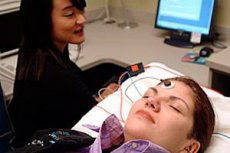Medical expert of the article
New publications
Electrocochleography
Last reviewed: 04.07.2025

All iLive content is medically reviewed or fact checked to ensure as much factual accuracy as possible.
We have strict sourcing guidelines and only link to reputable media sites, academic research institutions and, whenever possible, medically peer reviewed studies. Note that the numbers in parentheses ([1], [2], etc.) are clickable links to these studies.
If you feel that any of our content is inaccurate, out-of-date, or otherwise questionable, please select it and press Ctrl + Enter.

A diagnostic method called electrocochleography measures the electrical potentials produced by the inner ear during the passage of sound vibrations. This procedure is relevant in determining the excess amount of fluid in the inner ear cavity. In particular, the procedure is carried out:
- in case of hearing impairment;
- when noise and ringing in the ears appears;
- if you feel a feeling of congestion in your ear.
Special equipment is used for the research, and testing lasts from 40 minutes to an hour and a half.
Indications for the procedure
The following situations are considered grounds for conducting electrocochleography:
- paroxysmal dizziness, repeated against the background of noise or ringing in the ears, decreased hearing function;
- sensorineural hearing loss in one ear;
- congestion or a feeling of pressure in the ear that does not respond to impedance testing;
- periodic dizziness, unsteady gait;
- diagnosis of Meniere's disease;
- monitoring the dynamics of treatment of ear diseases.
Electrocochleography is very often used in pediatrics, to determine the hearing threshold and for other purposes:
- when assessing hearing in children with increased excitability of the central nervous system;
- in differential diagnostics of sensorineural and conductive hearing loss.
Preparation
Before the electrocochleography procedure, the doctor performs otoscopy – an examination of the ear canals. For this, a backlight and a forehead reflector are used, which reflects rays into the cavity of the ear being examined.
If necessary, the auricle and passages are cleaned of residual sulfur. The eardrum is irrigated with isotonic sodium chloride solution.
There are no other special measures to prepare for the electrocochleography procedure. After testing, the patient can go home on their own.
Examination of small children may be performed using general anesthesia. This should be taken into account by the child's parents: before going to the procedure, it is necessary to discuss the issues of preparing the child with the anesthesiologist and the doctor who will perform the diagnostics.
How is electrocochleography performed?
Before the electrocochleography procedure, the patient is placed in a soundproof room and laid on his side, so that the ear being examined is at the top. Under the supervision of a doctor, a special electrode is inserted using an otoscope and secured with a clamp located near the microphone. The second electrode, intended for grounding, is adjusted at the level of the seventh cervical vertebra, and the negative electrode is adjusted at the level of the contralateral mastoid process. The procedure usually involves the use of silver-plated cup electrodes filled with an electrically conductive mass.
After fixing the electrodes, the doctor transmits electrical impulses in the form of short acoustic tones and sounds of different frequencies. The patient is warned that he will have specific sensations after the eardrum comes into contact with the electrode, and he must immediately inform the doctor that such sensations have appeared. Based on this data, as well as the results obtained in the form of a graph of amplitudes and potentials, the doctor will be able to establish the correct diagnosis.
The person being examined will be able to go home immediately after the procedure, even if local anesthesia is administered. By the way, doctors do not welcome the use of local anesthesia during an electrocochleography session, as this increases the risk of accidental damage to the eardrum.

Contraindications
As a rule, electrocochleography has no contraindications and complications. If the patient has an allergy to local anesthetics used during the procedure, they are replaced with safer agents.
During testing, the patient may experience slight discomfort and unpleasant sensations in the hearing organs. However, these symptoms disappear without a trace immediately after the end of the electrocochleography procedure.


 [
[